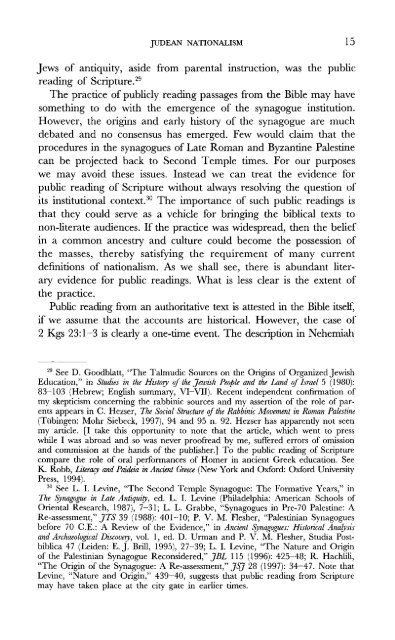historical perspectives: from the hasmoneans to bar kokhba in light ...
historical perspectives: from the hasmoneans to bar kokhba in light ...
historical perspectives: from the hasmoneans to bar kokhba in light ...
Create successful ePaper yourself
Turn your PDF publications into a flip-book with our unique Google optimized e-Paper software.
JUDEAN NATIONALISM 15<br />
Jews of antiquity, aside <strong>from</strong> parental <strong>in</strong>struction, was <strong>the</strong> public<br />
read<strong>in</strong>g of Scripture. 29<br />
The practice of publicly read<strong>in</strong>g passages <strong>from</strong> <strong>the</strong> Bible may have<br />
someth<strong>in</strong>g <strong>to</strong> do with <strong>the</strong> emergence of <strong>the</strong> synagogue <strong>in</strong>stitution.<br />
However, <strong>the</strong> orig<strong>in</strong>s and early his<strong>to</strong>ry of <strong>the</strong> synagogue are much<br />
debated and no consensus has emerged. Few would claim that <strong>the</strong><br />
procedures <strong>in</strong> <strong>the</strong> synagogues of Late Roman and Byzant<strong>in</strong>e Palest<strong>in</strong>e<br />
can be projected back <strong>to</strong> Second Temple times. For our purposes<br />
we may avoid <strong>the</strong>se issues. Instead we can treat <strong>the</strong> evidence for<br />
public read<strong>in</strong>g of Scripture without always resolv<strong>in</strong>g <strong>the</strong> question of<br />
its <strong>in</strong>stitutional context. 30 The importance of such public read<strong>in</strong>gs is<br />
that <strong>the</strong>y could serve as a vehicle for br<strong>in</strong>g<strong>in</strong>g <strong>the</strong> biblical texts <strong>to</strong><br />
non-literate audiences. If <strong>the</strong> practice was widespread, <strong>the</strong>n <strong>the</strong> belief<br />
<strong>in</strong> a common ancestry and culture could become <strong>the</strong> possession of<br />
<strong>the</strong> masses, <strong>the</strong>reby satisfy<strong>in</strong>g <strong>the</strong> requirement of many current<br />
def<strong>in</strong>itions of nationalism. As we shall see, <strong>the</strong>re is abundant literary<br />
evidence for public read<strong>in</strong>gs. What is less clear is <strong>the</strong> extent of<br />
<strong>the</strong> practice.<br />
Public read<strong>in</strong>g <strong>from</strong> an authoritative text is attested <strong>in</strong> <strong>the</strong> Bible itself,<br />
if we assume that <strong>the</strong> accounts are <strong>his<strong>to</strong>rical</strong>. However, <strong>the</strong> case of<br />
2 Kgs 23:1-3 is clearly a one-time event. The description <strong>in</strong> Nehemiah<br />
29 See D. Goodblatt, "The Talmudic Sources on <strong>the</strong> Orig<strong>in</strong>s of Organized Jewish<br />
Education," <strong>in</strong> Studies <strong>in</strong> <strong>the</strong> His<strong>to</strong>ry of <strong>the</strong> Jewish People and <strong>the</strong> Land of Israel 5 (1980):<br />
83-103 (Hebrew; English summary, VI-VII). Recent <strong>in</strong>dependent confirmation of<br />
my skepticism concern<strong>in</strong>g <strong>the</strong> rabb<strong>in</strong>ic sources and my assertion of <strong>the</strong> role of parents<br />
appears <strong>in</strong> C. Hezser, The Social Structure of <strong>the</strong> Rabb<strong>in</strong>ic Movement <strong>in</strong> Roman Palest<strong>in</strong>e<br />
(Tub<strong>in</strong>gen: Mohr Siebeck, 1997), 94 and 95 n. 92. Hezser has apparently not seen<br />
my article. [I take this opportunity <strong>to</strong> note that <strong>the</strong> article, which went <strong>to</strong> press<br />
while I was abroad and so was never proofread by me, suffered errors of omission<br />
and commission at <strong>the</strong> hands of <strong>the</strong> publisher.] To <strong>the</strong> public read<strong>in</strong>g of Scripture<br />
compare <strong>the</strong> role of oral performances of Homer <strong>in</strong> ancient Greek education. See<br />
K. Robb, Literacy and Paideia <strong>in</strong> Ancient Greece (New York and Oxford: Oxford University<br />
Press, 1994).<br />
30 See L. I. Lev<strong>in</strong>e, "The Second Temple Synagogue: The Formative Years," <strong>in</strong><br />
The Synagogue <strong>in</strong> Late Antiquity, ed. L. I. Lev<strong>in</strong>e (Philadelphia: American Schools of<br />
Oriental Research, 1987), 7-31; L. L. Grabbe, "Synagogues <strong>in</strong> Pre-70 Palest<strong>in</strong>e: A<br />
Re-assessment," JTS 39 (1988): 401-10; P. V. M. Flesher, "Palest<strong>in</strong>ian Synagogues<br />
before 70 C.E.: A Review of <strong>the</strong> Evidence," <strong>in</strong> Ancient Synagogues: His<strong>to</strong>rical Analysis<br />
and Archaeological Discovery, vol. 1, ed. D. Urman and P. V. M. Flesher, Studia Postbiblica<br />
47 (Leiden: E. J. Brill, 1995), 27-39; L. I. Lev<strong>in</strong>e, "The Nature and Orig<strong>in</strong><br />
of <strong>the</strong> Palest<strong>in</strong>ian Synagogue Reconsidered," JBL 115 (1996): 425-48; R. Hachlili,<br />
"The Orig<strong>in</strong> of <strong>the</strong> Synagogue: A Re-assessment," JSJ 28 (1997): 34-47. Note that<br />
Lev<strong>in</strong>e, "Nature and Orig<strong>in</strong>," 439-40, suggests that public read<strong>in</strong>g <strong>from</strong> Scripture<br />
may have taken place at <strong>the</strong> city gate <strong>in</strong> earlier times.

















